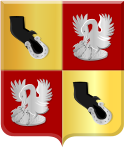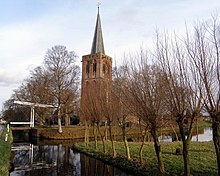Kortenhoef
 flag |
 coat of arms |
| province |
|
| local community |
|
|
Area - land - water |
14.81 km 2 9.85 km 2 4.96 km 2 |
| Residents | 6,755 (Jan. 1, 2017) |
| Coordinates | 52 ° 14 ' N , 5 ° 6' E |
| Important traffic route |
|
| prefix | 035 |
| Postcodes | 1211, 1216, 1223, 1231, 1241, 1243 |
| Location of Kortenhoef in the municipality of Wijdemeren | |
Kortenhoef is a village in the municipality of Wijdemeren in the Dutch province of North Holland and is just outside the Gooi . The original name was Curtevenne and it has always been a small street village on a dam, southeast of the Horstermeer polder. Kortenhoef is about five kilometers west of Hilversum and 20 km from the city center of Amsterdam .
Church history
The village itself consists of two parts, the old village on the Kortenhoefsedijk and Moleneind, and the new village, which is located to the northeast towards the 's-Gravelandsche polder. Kortenhoef was an independent municipality. From September 19, 1814 to October 1, 1819 it was part of the province of Utrecht . On January 1, 1966, it was merged with the villages of 's-Graveland and Ankeveen in the new administrative district of' s-Graveland. On January 1, 2002, 's-Graveland merged with Loosdrecht and Nederhorst den Berg to form the large municipality of Wijdemeren with around 23,186 inhabitants. The municipality of Kortenhoef was also known as Kortenhoef en Riethoven in the 19th century .
Kortenhoef is located in a wooded area and is known for its lake district. The Kortenhoefer Lakes are the result of centuries of peat cutting work in this fen area and are known for it. In addition, the reeds for the thatched roofs were extracted here. There was also fishing here. A larger area around Kortenhoef has meanwhile been converted into a polder landscape. Cattle were raised here, as was possible on the marshland - this area had a reputation for being very poor. There are currently only a few farms left. Many of the marginal, formerly agricultural areas have now been closed.
Kortenhoef was known in 1156 under the name Curtenvene . In 1235 the name was changed to Curtenhoven and from 1444 the small community was named Kortehoeff . According to the linguistic reconstruction, Kotenhoef is equated with the expression peat pruning - venne means peat and hoef hoof. Korten is synonymous with pruning. The church of Kortenhoef was built in the second half of the 14th century (approximately between 1350 and 1400). It is a late Romanesque hall church. In the 17th century the nave was changed and the turn received a new point. The floor plan was retained. The small choir is characteristic. The big difference to other churches in the area is that the church has retained its old floor plan to this day. This is due to the fact that the population has remained the same. So it was never enlarged. This church is the one most painted by artists in Holland.
Municipal coat of arms
The coat of arms of Kortenhoef was given to the municipality. This coat of arms was awarded on June 28, 1839 by the High Council by the nobility to honor Kortenhoef as a polder community. The community had led it to the reform of the community and was at the same time its official seal.
The coat of arms consists of a shield and a helmet crown on the upper edge . The coat of arms is divided into three parts. Dominating in the head of the shield and the bar are two equal, pictorial representations of animals. On the right is a hoofed, hovering black horse's foot from the heart to the upper right, growing on a golden background. On the left is a pelican with three young birds sitting in the nest in silver on a red background. The base consists of a river on a green ground. A three-part bar in gold floats on this to the river and to the right and left side edge.
Bibliography
- Broude, Norma (1990): Impressionism - an international art movement 1860-1920 , DuMond Buchverlag Cologne, ISBN 3-8321-7454-0 .
- Denninger-Schreuder, Carole (1998): De onvergankelijke kijk op Kortenhoef: een schildersdorp in beeld , THOT, Bussum, ISBN 978-9-068-68215-1 .
- van Dijke, Frouke and van den Heuvel, Maartje (2015): Holland op z'n mooist , Uitgeverij WBOOKS, ISBN 978-9-462-58086-2 .
- Heymann, Matthias, The History of Wind Energy Use 1890–1990 , Campus Verlag, Frankfurt / Main, ISBN 978-3-593-35278-7 .
- Nescio and Frerichs, L. (2015): De uitvreter • Titaantjes • Dichtertje • Mene Tekel , Singel Uitgeverijen, ISBN 978-9-038-89304-4 .
- Oswald, Gert (2006): Lexicon of Heraldry , 2nd unchanged edition, Battenberg-Verlag, ISBN 978-3-86646-010-2 .
- Sillevis, John; Kraan, Hans and Dorn, Roland 1987: The Hague School, masterpieces of Dutch painting of the 19th century from the Haags Gemeentemuseum , exhibition cat. Kunsthalle Mannheim, Edition Braus, ISBN 3-925835-08-3 .
Web links
Individual evidence
- ↑ Kerncijfers wijken en buurten 2017 Centraal Bureau voor de Statistiek , accessed on May 19, 2018 (Dutch)
- ↑ The reason for the land reclamation is the unique drainage via a drainage ditch system, wind pumps , which raised the extracted water to an artificial and natural receiving water and from there it was discharged to the sea via a gradient.
- ↑ In addition, see also Matthias Heymann, pp. 44 to 47.
- ↑ This is why the horse's hoof has also been included in the coat of arms.
- ↑ This crown of rank has its origin in the Danish, Italian, Spanish and French marquis ( margrave ) crown (Oswald, 2006).
- ↑ The pelican is rarely found in heraldry as a swimming bird . In mythology it is equated with willingness to make sacrifices. According to legend, the pelican opened its chest to nourish the brood with its blood. In Christianity he is a symbol of Christ as Savior (Oswald, 2006).
- ↑ The gold tone did not emerge until the 19th century when people started to introduce fantasy colors. In the past there was only yellow as a color in the sign.


